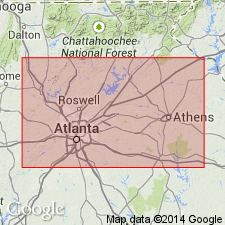
- Usage in publication:
-
- Schist of Hulett*
- Modifications:
-
- Named
- Dominant lithology:
-
- Schist
- AAPG geologic province:
-
- Piedmont-Blue Ridge province
Summary:
Informally named schist of Hulett, part of parautochthonous assemblage in axial area of Austell-Frolona anticlinorium. Named for Hulett, Carroll Co., western GA; exposures are seen in and around the town. Typical exposures may be seen along unnamed, unpaved road running south-southeast from GA Hwy 166 about 320 m southeast of Hulett for approximately 2130 m south of GA Hwy 166. Consists of biotite-muscovite schist that contains small red garnets in many outcrops and lacks garnets in nearly as many outcrops; also persistent is presence of closely spaced schistosity planes that give rock a finely cleaved appearance. Underlies Bill Arp Formation but nature of contact is not known. Also unknown as to whether this schist belongs with either Frolona or Bill Arp Formations; therefore the schist is given informal status until further mapping can better define its assignment. Age is Late Proterozoic to Middle Ordovician.
Source: GNU records (USGS DDS-6; Reston GNULEX).
For more information, please contact Nancy Stamm, Geologic Names Committee Secretary.
Asterisk (*) indicates usage by the U.S. Geological Survey. Other usages by state geological surveys.
"No current usage" (†) implies that a name has been abandoned or has fallen into disuse. Former usage and, if known, replacement name given in parentheses ( ).
Slash (/) indicates name does not conform with nomenclatural guidelines (CSN, 1933; ACSN, 1961, 1970; NACSN, 1983, 2005). This may be explained within brackets ([ ]).

